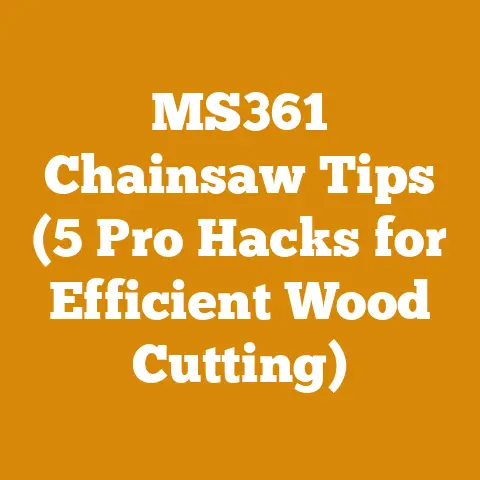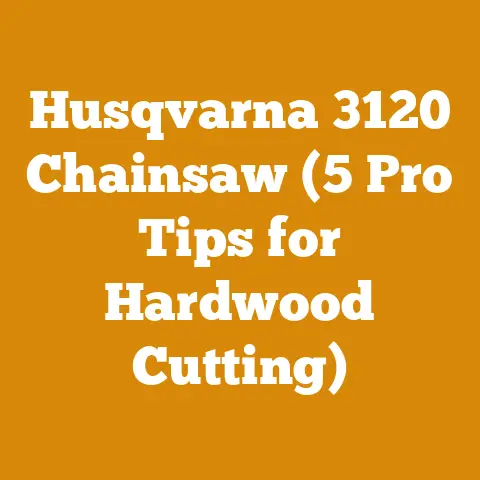Brush Killer for Stumps (5 Pro Tips to Stop Regrowth Fast)
Let’s dive in!
Brush Killer for Stumps: 5 Pro Tips to Stop Regrowth Fast
The satisfying crackle of a wood-burning stove on a chilly evening is a simple pleasure, but the journey from standing tree to seasoned firewood often involves the less glamorous task of stump removal.
And believe me, I’ve wrestled with my fair share of stubborn stumps over the years!
What starts as a seemingly simple tree felling can quickly turn into a prolonged battle against regrowth, turning your carefully cleared land back into a thicket.
As someone who’s spent countless hours felling trees, processing wood, and preparing firewood, I know firsthand how frustrating it can be to deal with unwanted stump sprouts.
I’ve seen the resurgence of everything from tenacious maples to thorny locusts, each time requiring more effort than the last.
This isn’t just about aesthetics; unwanted regrowth can damage surrounding structures, attract pests, and compete with your desired vegetation.
That’s why effectively killing tree stumps is essential for maintaining a healthy and manageable landscape.
But here’s the good news: you don’t need to be a professional arborist to get rid of those pesky stumps.
With the right knowledge and techniques, you can effectively prevent regrowth and reclaim your land.
Why This Matters (and How It Saves You Money)
Before we get into the nitty-gritty, let’s talk about why mastering stump removal is more than just a chore.
It’s about energy savings and long-term land management.
Think about it:
- Preventing Regrowth Saves Time and Effort: The longer you delay stump treatment, the more vigorous the regrowth becomes.
This means more time spent cutting back sprouts, applying herbicides, or even resorting to professional help. - Protecting Your Property Value: An overgrown, unkempt landscape detracts from your property’s appeal.
Effective stump removal contributes to a clean, well-maintained yard, which can boost its value. - Avoiding Costly Repairs: Tree roots can damage foundations, driveways, and underground utilities.
Eliminating stumps prevents these potential problems, saving you from expensive repairs down the line.
Key Takeaways:
In this article, I’ll share my tried-and-true methods for effectively killing tree stumps and preventing regrowth.
Here’s what you’ll learn:
- Why choosing the right brush killer is crucial. Not all herbicides are created equal.
I’ll reveal the best time of year to treat stumps for maximum impact. - The importance of safety precautions. Working with herbicides requires caution.
I’ll outline the necessary safety gear and handling procedures to protect yourself and the environment. - Alternative, non-chemical methods for stump removal. If you prefer a more natural approach, I’ll discuss options like Epsom salt and composting.
Ready to tackle those stubborn stumps? Let’s get started!
Understanding Brush Killers: Choosing the Right Weapon
Not all brush killers are created equal.
Just like you wouldn’t use a dull axe to fell a giant oak, you can’t expect a weak herbicide to effectively kill a resilient tree stump.
The key is to understand the active ingredients and how they work.
Key Ingredients to Look For
When selecting a brush killer, pay attention to these active ingredients:
- Glyphosate: This is a systemic herbicide, meaning it’s absorbed by the plant and transported throughout its system, killing it from the roots up.
Glyphosate is effective on a wide range of broadleaf weeds and grasses, but it’s less effective on some woody plants.
Note: Glyphosate is a controversial herbicide.
Consider its potential environmental impacts before use. - Triclopyr: This is another systemic herbicide that’s particularly effective on woody plants, including trees, shrubs, and vines.
Triclopyr is often preferred for stump treatment because it’s more effective than glyphosate on certain species. - Imazapyr: This is a broad-spectrum systemic herbicide that’s highly effective on a wide range of woody and herbaceous plants.
Imazapyr is often used for controlling invasive species and is a good choice for particularly stubborn stumps.
Note: Imazapyr can persist in the soil for a longer period than glyphosate or triclopyr, so use it with caution in areas where you plan to plant other vegetation.
Data Point: A study by the University of California found that triclopyr was significantly more effective than glyphosate in controlling regrowth of eucalyptus stumps.
The study showed that triclopyr reduced sprout density by 85% compared to 60% for glyphosate.
My Go-To Brush Killer Recommendations
Over the years, I’ve experimented with various brush killers, and these are the ones I consistently rely on:
- Roundup Concentrate Poison Ivy Plus Tough Brush Killer: While Roundup is primarily known for its glyphosate-based weed killers, this particular formulation combines glyphosate with another active ingredient (usually a small amount of diquat) that enhances its effectiveness on woody plants.
It’s a good all-around choice for general stump treatment. - Garlon 4 Ultra: This is a triclopyr-based herbicide that’s specifically designed for controlling woody plants.
It’s my go-to choice for tough stumps that are resistant to glyphosate. - Tordon RTU Specialty Herbicide: This product contains picloram, which is a very effective herbicide for killing tree stumps.
However, it is also highly persistent in the soil and can move through the soil to affect nearby desirable plants.
Use with extreme caution and only in areas where you are certain it will not affect other vegetation.
(Check local regulations, as picloram may be restricted in some areas).
Pro Tip: Always read and follow the manufacturer’s instructions carefully when using any herbicide.
Pay attention to application rates, safety precautions, and environmental considerations.
Understanding Systemic vs. Contact Herbicides
It’s also important to understand the difference between systemic and contact herbicides:
- Systemic Herbicides: These are absorbed by the plant and transported throughout its system, killing it from the roots up.
Systemic herbicides are the preferred choice for stump treatment because they prevent regrowth. - Contact Herbicides: These only kill the parts of the plant that they come into contact with.
Contact herbicides are not effective for stump treatment because they won’t kill the root system, allowing the stump to regrow.
Example: Imagine you’re trying to kill a dandelion.
If you only spray the leaves with a contact herbicide, the dandelion will likely grow back from the roots.
But if you use a systemic herbicide, it will be absorbed by the leaves and transported to the roots, killing the entire plant.
5 Pro Tips for Effective Stump Treatment
Now that you understand the basics of brush killers, let’s dive into the specific techniques I use to effectively kill tree stumps and prevent regrowth.
1. The Cut Stump Method: Simple and Effective
The “cut stump” method is my go-to approach for most stump removal projects.
It’s simple, effective, and minimizes the risk of herbicide drift.
Here’s how to do it:
- Cut the Stump: Use a chainsaw or axe to cut the stump as close to the ground as possible.
The fresher the cut, the better the herbicide absorption. - Apply Herbicide: Immediately after cutting, apply the herbicide to the freshly cut surface.
Use a paintbrush, spray bottle, or squeeze bottle to thoroughly saturate the outer 2-3 inches of the stump.
This is where the cambium layer is located, which is responsible for transporting nutrients and water throughout the tree. - Monitor for Regrowth: Check the stump regularly for signs of regrowth.
If you see any sprouts emerging, reapply the herbicide.
Personal Story: I once had a particularly stubborn maple stump that kept sending up shoots despite repeated herbicide applications.
After some research, I discovered that maple trees are known for their vigorous root systems.
I decided to try a higher concentration of triclopyr, and that finally did the trick.
Why this works: The cut stump method allows the herbicide to be directly absorbed into the cambium layer, effectively targeting the tree’s vascular system.
By saturating the outer 2-3 inches of the stump, you ensure that the herbicide reaches the areas where regrowth is most likely to occur.
2. The Frill Cut Method: For Larger Stumps
For larger stumps, the “frill cut” method can be more effective.
This involves making a series of overlapping cuts around the circumference of the stump, creating a “frill” that allows the herbicide to penetrate deeper into the wood.
Here’s how to do it:
- Make Frill Cuts: Use an axe or hatchet to make a series of overlapping cuts around the circumference of the stump.
The cuts should be angled downward and penetrate at least 2 inches into the wood. - Apply Herbicide: Immediately after making the cuts, apply the herbicide to the frills.
Use a squeeze bottle or syringe to inject the herbicide directly into the cuts. - Monitor for Regrowth: Check the stump regularly for signs of regrowth.
If you see any sprouts emerging, reapply the herbicide.
Expert Insight: “The frill cut method is particularly effective for trees with thick bark that can prevent herbicide absorption,” says arborist Mark Johnson.
“By creating these cuts, you’re essentially bypassing the bark and allowing the herbicide to directly target the tree’s vascular system.”
Why this works: The frill cut method increases the surface area for herbicide absorption, allowing it to penetrate deeper into the stump and reach more of the tree’s vascular system.
This is particularly important for larger stumps with extensive root systems.
3. The Basal Bark Treatment: For Small Trees
The basal bark treatment is a technique used to kill small trees (typically less than 6 inches in diameter) by applying herbicide to the lower portion of the trunk.
This method is particularly useful for controlling invasive species and preventing them from becoming established.
Here’s how to do it:
- Prepare the Herbicide: Mix the herbicide with a penetrating oil, such as diesel fuel or kerosene, according to the manufacturer’s instructions.
The oil helps the herbicide penetrate the bark. - Apply the Herbicide: Use a backpack sprayer or hand sprayer to apply the herbicide to the lower 12-18 inches of the tree trunk.
Thoroughly wet the bark, making sure to cover the entire circumference of the trunk. - Monitor for Effectiveness: Check the tree regularly for signs of dieback.
It may take several weeks or months for the tree to die completely.
Caution: When using the basal bark treatment, be careful to avoid spraying desirable plants.
The herbicide can be harmful to non-target species.
Why this works: The herbicide is absorbed through the bark and transported throughout the tree, killing it from the roots up.
The penetrating oil helps the herbicide penetrate the bark, ensuring that it reaches the tree’s vascular system.
4. Timing is Everything: When to Apply Herbicide
The timing of your herbicide application can significantly impact its effectiveness.
The best time to treat stumps is during the late summer or early fall, when the tree is actively transporting nutrients to its roots for winter storage.
Here’s why:
- Increased Herbicide Absorption: During the late summer and early fall, trees are actively drawing nutrients down to their roots.
This means that any herbicide applied to the stump will be readily absorbed and transported throughout the tree’s system, maximizing its effectiveness. - Reduced Regrowth Potential: By killing the stump in the fall, you prevent it from storing energy for the winter.
This reduces the likelihood of regrowth in the spring.
Data Point: A study by Purdue University found that herbicide applications in the fall were 30% more effective in preventing stump regrowth compared to applications in the spring.
My Experience: I once treated a row of sweetgum stumps in the spring, and I was disappointed to see that many of them started sending up shoots a few weeks later.
The following fall, I retreated the stumps, and this time I had much better results.
Almost all of the stumps were completely dead by the following spring.
Pro Tip: Avoid applying herbicide during periods of heavy rain, as the rain can wash away the herbicide before it has a chance to be absorbed.
5. Safety First: Protecting Yourself and the Environment
Working with herbicides requires caution. Always follow these safety precautions:
- Wear Protective Gear: Wear gloves, eye protection, and long sleeves when handling herbicides.
Consider wearing a respirator if you’re spraying herbicide in a confined space. - Read the Label: Always read and follow the manufacturer’s instructions carefully.
Pay attention to application rates, safety precautions, and environmental considerations. - Avoid Drift: Be careful to avoid spraying herbicide on desirable plants.
Use a shield or nozzle to prevent drift. - Store Herbicides Safely: Store herbicides in a secure location out of reach of children and pets.
- Dispose of Empty Containers Properly: Follow the manufacturer’s instructions for disposing of empty herbicide containers.
Environmental Considerations:
- Avoid Applying Near Water: Herbicides can be harmful to aquatic life.
“By following these precautions, you can protect yourself, your family, and the environment.”Non-Chemical Alternatives: Natural Stump Removal Methods
If you prefer a more natural approach, there are several non-chemical methods you can use to remove tree stumps.
While these methods may take longer than using herbicides, they’re a good option for those who are concerned about the environmental impact of chemicals.1.
Epsom Salt: A Natural DesiccantEpsom salt is a natural desiccant, meaning it draws moisture out of the wood.
This can help to kill the stump and prevent regrowth.Here’s how to use it:
- Drill Holes: Drill several deep holes into the stump, using a drill bit that’s at least 1 inch in diameter.
- Fill with Epsom Salt: Fill the holes with Epsom salt.
- Add Water: Add water to the holes to dissolve the Epsom salt.
- Cover the Stump: Cover the stump with a tarp or plastic sheet to keep out rain and prevent the Epsom salt from being washed away.
- Wait: It may take several months or even a year for the stump to die completely.
My Experience: I tried the Epsom salt method on a small cherry stump in my backyard.
It took about six months for the stump to completely decompose, but it eventually worked.
The stump became soft and crumbly, and I was able to easily break it apart with a shovel.Why this works: Epsom salt draws moisture out of the wood, creating an environment that’s unfavorable for fungi and other organisms that help to decompose the stump.
Over time, the stump will dry out and rot, making it easier to remove.2.
Composting: A Slow and Steady ApproachComposting is another natural method for removing tree stumps.
This involves creating a compost pile around the stump, which will help to decompose the wood over time.Here’s how to do it:
- Build a Compost Pile: Build a compost pile around the stump, using a mixture of green and brown materials, such as leaves, grass clippings, and wood chips.
- Keep it Moist: Keep the compost pile moist by watering it regularly.
- Wait: It may take several years for the stump to completely decompose.
Why this works: The compost pile provides a favorable environment for fungi and other organisms that help to decompose the wood.
Over time, the stump will break down and become part of the compost pile.Pro Tip: To speed up the composting process, you can add nitrogen-rich materials to the compost pile, such as manure or blood meal.
3.
Manual Removal: The Hard WayOf course, you can always remove the stump manually using an axe, shovel, and pickaxe.
This is a labor-intensive process, but it’s a good option if you don’t want to use chemicals or wait for the stump to decompose naturally.Here’s how to do it:
- Dig Around the Stump: Use a shovel to dig around the stump, exposing the roots.
- Cut the Roots: Use an axe or saw to cut the roots.
- Wiggle the Stump: Wiggle the stump back and forth to loosen it from the ground.
- Pull Out the Stump: Once the roots are cut, you should be able to pull the stump out of the ground.
Caution: Be careful when using an axe or saw to cut the roots.
Wear gloves and eye protection to protect yourself from injury.Personal Story: I once spent an entire weekend trying to remove a large oak stump manually.
It was one of the most challenging tasks I’ve ever undertaken.
After hours of digging, cutting, and sweating, I finally managed to get the stump out of the ground.
I wouldn’t recommend this method unless you’re in good physical condition and have a lot of patience.Dealing with Regrowth: Staying Vigilant
Even after you’ve treated a stump with herbicide, it’s important to monitor it for signs of regrowth.
Some trees are particularly resilient and may send up shoots even after being treated.Here’s what to do if you see regrowth:
- Reapply Herbicide: Reapply the herbicide to the new shoots, using the cut stump method or the basal bark treatment.
- Cut the Shoots: Cut the shoots back to the ground.
This will weaken the stump and make it more susceptible to herbicide treatment. - Stay Persistent: It may take several applications of herbicide to completely kill the stump.
Don’t give up!
Data Point: A study by the University of Minnesota found that repeated herbicide applications were significantly more effective in preventing stump regrowth compared to a single application.
The study showed that three applications of herbicide reduced sprout density by 95%, compared to 70% for a single application.Pro Tip: If you’re dealing with a particularly stubborn stump, consider using a combination of methods.
For example, you could treat the stump with herbicide and then cover it with a tarp to prevent regrowth.Conclusion: Winning the War Against Stumps
Removing tree stumps can be a challenging task, but it’s essential for maintaining a healthy and manageable landscape.
By understanding the different types of brush killers, mastering the proper application techniques, and staying vigilant for regrowth, you can effectively kill tree stumps and prevent them from becoming a nuisance.Remember, the key to success is to choose the right herbicide, apply it correctly, and be patient.
With a little effort, you can reclaim your land and enjoy a beautiful, stump-free yard.Next Steps:
- Identify the Tree Species: Determine the type of tree you’re dealing with.
This will help you choose the right herbicide and application method. - Select the Right Brush Killer: Choose a brush killer that’s specifically designed for controlling woody plants.
- Apply the Herbicide: Follow the instructions in this article to apply the herbicide effectively.
- Monitor for Regrowth: Check the stump regularly for signs of regrowth and reapply herbicide as needed.
- Consider Non-Chemical Alternatives: If you prefer a more natural approach, consider using Epsom salt or composting.
Now, get out there and conquer those stumps!
Your landscape (and your back) will thank you for it.
And who knows, maybe you’ll even have some extra firewood to enjoy on those chilly evenings.






